Research - (2021) Volume 0, Issue 0
Core factors influenced the number of blood-sucking midges (Diptera, Simuliidae)
O.A. Fiodorova*Abstract
Introduction: The article presents the results of many years of research, a study of the breeding sites of bloodsucking diptera in the south of the Tyumen region, and the influence of environmental factors on the number of preimaginal phases of development of these insects. Materials and Methods: The collection and counting of the number of the preimaginal phases of diptera was carried out according to accepted methods. The results showed that in the south of the Tyumen region the main breeding grounds for diptera are the Iset and Pyshma rivers and small rivers and streams. Depending on the season, the number of midges can undergo significant changes, which is because of the hydrological regime of the rivers. The maximum density of larvae and pupae-390 individuals per 1 dm2 of substrate was recorded in 2007, the minimum was noted in 2006 and 2014, it ranged from 2 to 97 individuals/dm2, when the spring increase in the water level in the rivers was insignificant, the low number of larvae and pupae was due to the prevailing meteorological conditions in these years. The major factors hindering the development of diptera in a reservoir are the low speed of water flow, turbidity, and pollution with industrial and domestic waste. Conclusion: the factor limiting their number is the slow speed of water flow; that is why the practice of building dams on small rivers, in order to create reservoirs for watering animals in pastures, ensures the limitation of the number of larvae and pupae of diptera.
Keywords
Density, Biotope, Diptera, Larvae, Pupae, Ecological factors.
Introduction
Biting midges (Diptera, Simuliidae) are widespread in Russia and cause significant damage to the national economy of the country. Diptera develop in fast-flowing water bodies of various sizes, from small streams to the largest rivers. Particularly favorable for the accumulation of diptera are small waterfalls with air bubbles and a suitable substrate, as well as fast rifts, under bridges, below dams, and bars, where the current speed exceeds 0.5 m per second. According to many authors (Fedorova, et al., 2014; Grebelsky, 1972; Yankovsky, 2002), the level of spring flood has a significant influence on the time of development and the number of emerging diptera.
A dense network of flowing water bodies, which differ in size, flow rate, and physico-chemical properties of water covers the entire territory of the Tyumen region. The presence of a well-branched hydrological network makes this region favorable for dipteran breeding, the number of which in some seasons can reach a top level The region has a continental climate, which is characterized by brief summers, severe winters with strong winds, periods of cold weather in spring,, late spring and early autumn frosts (Sivkova, 2010).
The aggravation of the epidemiological situation associated with the activation of some natural focal diseases in the European part of Russia causes the study of the ecology of an important link in parasitic systems, carriers of their pathogens (blood-sucking ticks and dipterans) in the regional aspect. Among the hematophages, blood-sucking insects (Diptera, Simuliidae) are of well-known importance, being ectoparasites and vectors of onchocerciasis, anaplasmosis, tularemia, etc.
The history of the study of midges in Siberia is closely connected with the economic development of the land and with the problem of protecting people and animals from gnats. The results of long-term studies of the fauna and ecology of diptera are given in the papers of Radzivilovskaya, (1950), Shevtsova, (2001) and others. Literary data on the association of blood-sucking diptera with various biotopes in the Tyumen region are limited. The study of this aspect of the ecology of diptera in the Yamalo-Nenets autonomous Okrug was carried out by V.D. Patrusheva and L.V. Boldarueva. There were no such studies in the south of the Tyumen region. Larvae and pupae developing in various water flows were considered a concomitant object of study, but it is known that the activity of attacks by diptera on warm-blooded hosts also depends on the conditions of development of the preimaginal stages.
On the territory of the studied region, blood-sucking diptera are widespread and cause significant damage being ectoparasites for humans and farm animals, and vectors of dangerous infectious and invasive diseases.
According to data from the literature and our own research, it was revealed that the main environmental factors that influence the presence in rivers and streams of preimaginal phases of diptera and their population density are the level of spring floods on rivers, the rivers, water temperature, flow rate, the turbidity, and pollution with organic substances.
Understanding the factors that determine the prevalence of bloodsucking diptera is critical to predicting how populations will respond to environmental changes. Today, the topic is relevant and requires further studies.
The aim of our work was to study the major breeding sites of bloodsucking diptera in the south of the Tyumen region, the ecological features of these reservoirs, and their influence on the number of preimaginal phases of development of simuliids.
Materials and Methods
Systematic screening of breeding sites and their infestation with blood sucking diptera of the Simuliidae family Simuliidae were carried out in 2006-2008 in the south of the Tyumen region in three climate zones (subzones): south taiga (Nizhnetavdinsky region-Tavda river (57°47′54’′N, 67°15′24″E), the Iska river (left tributary of the Tobol) and Saranka river (right tributary of the Tavda), birch-aspen forests (Tyumen region-Tura river (58°23′05′N 59°20′05″E), the Pyshma with right tributaries the Tsinga, Baldushka and Yalutorovsky district Tobol river (58°09′14’′N, 68°12′55″E), in the forest-steppe zone of the Isetsky district the Iset river (left tributary of the Tobol) (56°35′57″N, 66°17′16″E) with tributaries the Yuzey, the Beshkilka, the Beshkilom river in the area, in Krasnovo village and yhe Iryum river in Barkhatovo village). The laboratory of entomology and disinsection of the VNIIVEA branch of the Tyumen Scientific Center of the SB RAS carried the work out.
The reservoir screening was carried out once a decade, throughout the summer until late autumn. The following data was recorded: water temperature, flow rate and the water level.
The count of the number of larvae and pupae of diptera was carried out according to the accepted methods, the collection was carried out by manual collection together with the substrate. We calculated density per 1 dm2 (Radzivilovskaya, 1950; Shevchenko, 1989).
Simultaneously with counting, the meteorological conditions were recorded: temperature, illumination, relative humidity, and wind speed.
Results
The natural conditions in the south of the Tyumen region are favorable for the mass emergence of blood-sucking dipterans of the «midges» complex, where they are widespread and cause significant harm to agriculture.
Studies on the fauna and ecology of blood-sucking diptera in the region's south were carried out mainly in the 1960s-seventies of the last century, we have not studied them for over 40 years. In increasing anthropogenic impact on nature, the study of the current state of the fauna and ecology of diptera, in various natural and climatic conditions in the region's south, is very pressing.
Study of breeding sites showed that each of these reservoirs is an ecologically unique biotope with a certain hydrological regime and a characteristic complex of nesting diptera. A characteristic feature of these waters is that they are all on flat land, characterised by spring-summer floods and a variety of current velocities.
The Tobol River: the bank is steep, the bottom is sandy silty, with a current speed of 0.25 m/s. The Pyshma River (Fig. 5) is one of the main reservoirs for diptera breeding: the bank is steep, the bottom is sandy silty, the current speed is 0.25 m/s. The Tura River: current speed is not less than 0.25 m/s, the bottom is sandy silty. We recorded the turbidity of the water in this river. The Iset River (Fig. 1 and 2): the speed of the current is not less than 0.25 m/s, the bank is steep; the bottom is sandy-silty. The Iska River (Fig. 3 and 4): width-5 m, depth-1-2 m, current speed-0.6 m/s, rocky bottom.
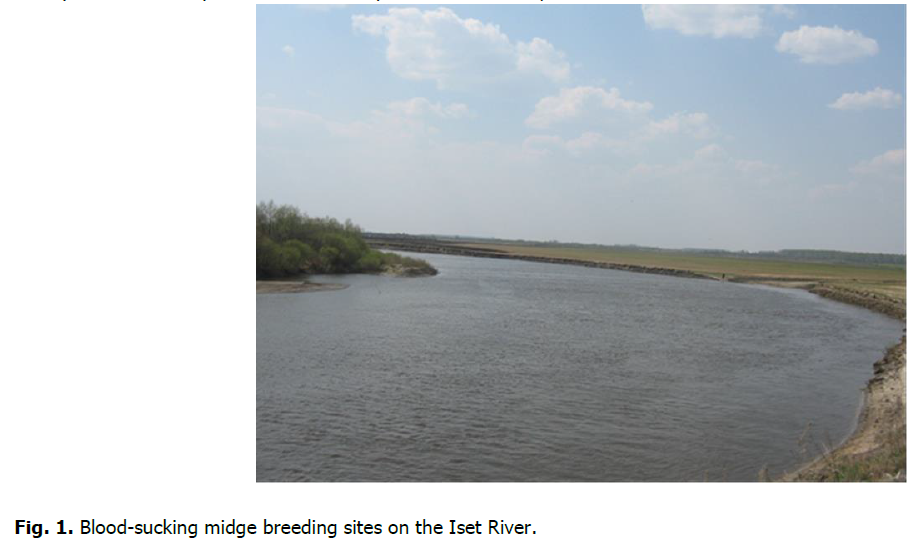
Fig 1. Blood-sucking midge breeding sites on the Iset River.
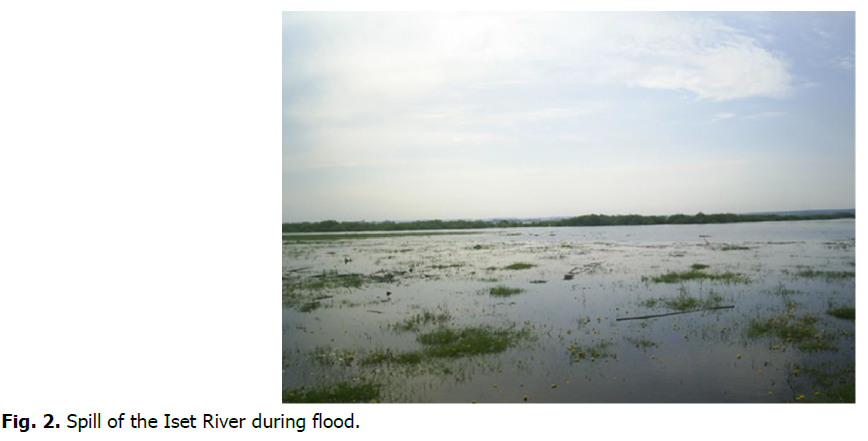
Fig 2. Spill of the Iset River during flood.
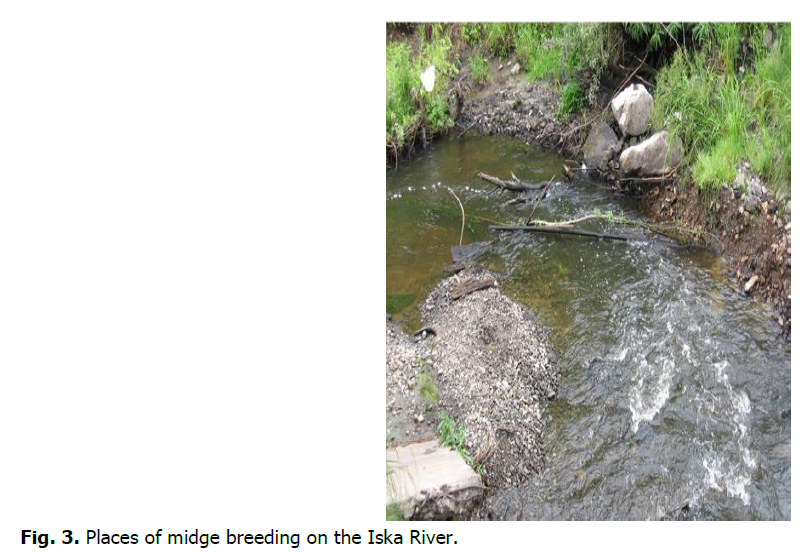
Fig 3. Places of midge breeding on the Iska River.
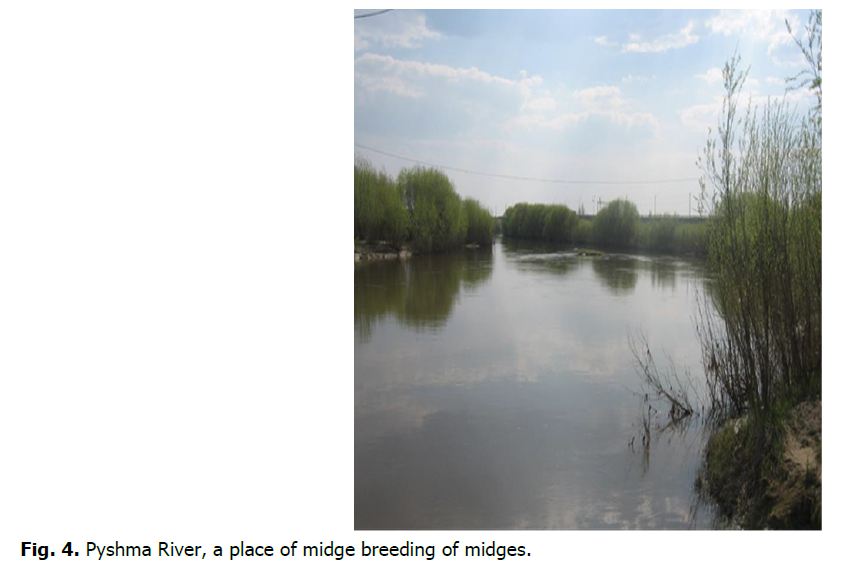
Fig 4. Pyshma River, a place of midge breeding of midges.
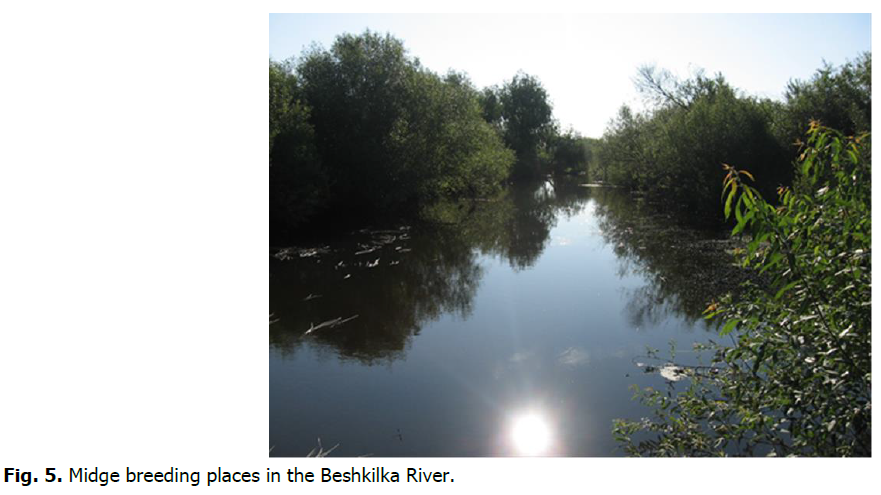
Fig 5. Midge breeding places in the Beshkilka River.
The Saranka river: Width 5m, depth-1-2 m, current speed 0.3 m/s, rocky bottom. The Tsinga and Baldushka (Fig. 6) rivers: width about 5 m, depth 1-2 m, current speed-0.1-0.2 m/s, sandy-silty bottom. The Beshkilka River (Fig. 6): the width of the river is about 5 m, the depth is 1-2 m, current speed is 0.5 m/s, the bottom is rocky.
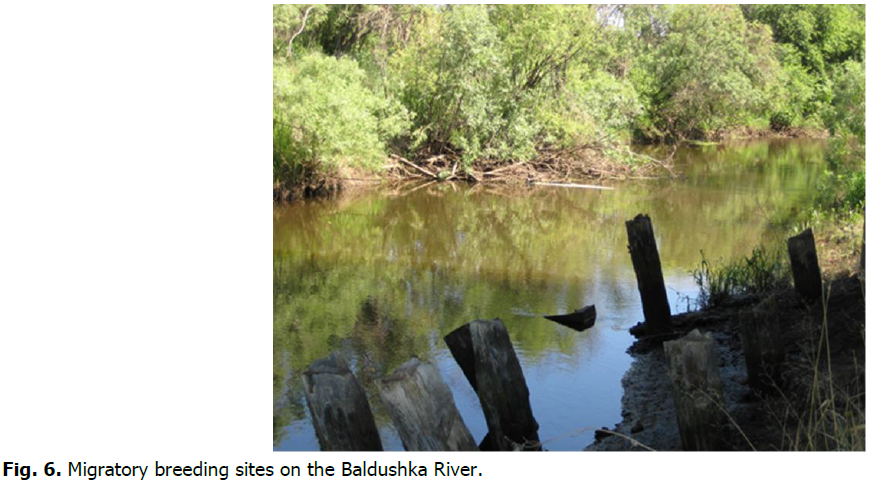
Fig 6. Migratory breeding sites on the Baldushka River.
The small rivers Beshkil and Iryum flow in the inundation plots of pastures and serve as a watering place for animals. There are numerous dams (ponds), the speed of their flow is reduced, and sometimes stagnation of water can be recorded. Their width is 2-5m. In such rivers, diptera pupa larvae were found only in water passages. On the river Beshkil, where there is limited flow of water through the pipe in the dam, larvae and pupae were found above the dam, directly in the pipe itself, and below the dam, where water falls from the pipe and gets enriched with oxygen. In addition, the flow rate decreases again because of the backwater of the next dam. Repeated examination of the Iryum and Beshkil in backwater areas of backwater at a flow rate of 0.1 m/s did not reveal larvae and pupae. We examined the Yuzya River near the mouth near the bridge that crosses it. Because of the construction of the bridge, the soil was sand and gravel, and the depth of the river in this area was 15-30 cm with a width of about 2 m. Above and below the bridge, the bottom of the river is silty down to 1 m deep. Single larvae and pupae were found on sedge leaves and stones on the rift, and above and below it, they were not found, apparently because of the slow current.
According to the research of V.U. Mitrokhin in the region's south, most species of diptera winter in the egg phase, and the first larvae appear in the third decade of April. In the biotopes studied, larvae of 2-3rd instar were found in water flows in early May at water temperatures up to 6.3°C and were recorded until August. We observed the appearance of the first pupae in the second decade of May, and the average density of larvae and pupae of diptera was different. The density of larvae and pupae depended on the research season. The density of larvae and pupae on the substrate has significant differences, sometimes reaching up to 390 individuals per 1 dm2. During the research period, the water temperature ranged from 6.3 to 25°C and the air temperature from 16 to 30°C.
For reference, the population density of the preimaginal phases of midges in different years of research (Table 1) showed that in 2006 and 2008, the average number of larvae and pupae was low and the water flows ranged from 2 to 97 individuals/dm2. The fact explains the low number of larvae and pupae that in 2006 and 2014 there was no spring flood; the rivers did not overflow the banks, which is because of the prevailing natural and climatic conditions; the fact that a change in water level leads to the death of the population also explained the low number of larvae and pupae of midges for reference in the preimaginal phase, confirming the data of many researchers (Shevchenko, 1988; Shevchenko, 1989).
| Watercourses | Year | Average Density (in the numerator-larvae, in the denominator-pupae). Month, decade. | Average number (∑=Larvae+ Pupae) | ||||||||||||
|---|---|---|---|---|---|---|---|---|---|---|---|---|---|---|---|
| May | June | July | Aug | Oct | |||||||||||
| 1 | 2 | 3 | 1 | 2 | 3 | 1 | 2 | 3 | 1 | 2 | 3 | 1 | |||
| Subzone of the southern taiga | |||||||||||||||
| Tobol river | 2008 | 2/20 | 22 | ||||||||||||
| Iska River | 2006 | 10/19 | 10/10 | 48/8 | 4/10 | 25/15 | 31.8 | ||||||||
| 2007 | 20/100 | 120 | |||||||||||||
| 2008 | 50/11 | 100/14 | 87.5 | ||||||||||||
| Tavda river | 2006 | 8/33 | 41 | ||||||||||||
| Saranka river p.CapaHKa | 2006 | 0/50 | 70/45 | 82.5 | |||||||||||
| Subzone of small-leaved aspen-birch forests | |||||||||||||||
| Pyshma river | 2006 | 0/21 | 30/9 | 0/100 | 10/20 | 10/20 | 20/15 | 37.5 | |||||||
| 2007 | 60/390 | 450 | |||||||||||||
| 2008 | 70/0 | 150/3 | 2/6 | 50/9 | 72.5 | ||||||||||
| Tsynga river | 2006 | 30/12 | 89/14 | 30/350 | 84/10 | 30/15 | 15/10 | 10/5 | 10/2 | 89.5 | |||||
| 2007 | 200/0 | 200 | |||||||||||||
| 2008 | 4/5 | 14/0 | 20/45 | 22/3 | 28.25 | ||||||||||
| Baldushka river | 2008 | 1/8 | 9 | ||||||||||||
| Tura river | 2008 | 20/5 | 25 | ||||||||||||
| Forest-steppe zone | |||||||||||||||
| Ishim river | 2006 | 2/20 | 22 | ||||||||||||
| Iset River | 2006 | 10/20 | 50/70 | 60/50 | 10/100 | 1/1 | 1/6 | 13/5 | 56.7 | ||||||
| 2007 | 30/100 | 1/70 | 1005 | ||||||||||||
| 2008 | 100/0 | 10/84 | 97 | ||||||||||||
| Beshkil river | 2006 | 1/50 | 51 | ||||||||||||
| Yuzya river | 2006 | 1/1 | 2 | ||||||||||||
| Beshkilka river | 2006 | 6/8 | 50/10 | 60/20 | 40/20 | 60/12 | 17/2 | 80/22 | 58.1 | ||||||
| 2007 | 20/10 | 100/60 | 1/10 | 67 | |||||||||||
| 2008 | 3/14 | 3/4 | 7/2 | 11 | |||||||||||
Table 1. Preimaginal phases of development of larvae and pupa.
In 2007, the highest average density of larvae and pupae ranged from 100.5 to 200 individuals/dm2 in the Pyshma, Iset, Tsinga, Iska rivers. This is because in 2007 there was a long flood in the rivers. Therefore, water flows were more intensively populated by diptera, this idea is in good agreement with the data of other researchers. So, according to V.U. Mitrokhin, it created the best conditions for the preimaginal development of the diptera when rivers overflow their banks during floods. High long-term flood, as showed by Z.V. Usova and M.V. Reva, favors the successful development of larvae, and the slow decline of water allows the development of the aquatic phases to be completed.
It should also be noted that the construction of dams on small rivers to create reservoirs in the region's south, with various economic purposes, including the watering animals in pastures, slows the current speed to a minimum (0.1 m/s) and contributes to a significant decrease in the number of the preimaginal phases of diptera. This method of regulating the number of diptera is one of the effective environmentally friendly methods of controlling diptera, which is also noted by other researchers (Ilyin, 2004; Prudkina, 1992; Rubtsov, 1962; Shipitsina, 1960; Yakuba, 1959; Yakuba, 1960).
Discussion
According to several authors (Fedorova, 2014; Grebelsky, 1972; Yankovsky, 2002), the development of the preimaginal phases of diptera depends mainly on the level and hydrological regime of the reservoir. According to the observations of V.D. Patrusheva, in large rivers in the Middle Ob region, the largest number of larvae is observed at a current speed of 0.7-1.2 m/s, and in small rivers, in areas where the current speed is 0.5-0.8 m/s. The speed of the current is one precondition for the development of diptera and, their distribution. Our research also confirms this idea, the absence of larvae in places of water retention, where the flow rate is below 0.2 m/s. Several authors point out that another factor in the distribution of diptera in breeding sites is pollution by sewage and littering of both the water flows themselves and the territories of river valleys with household and industrial waste (Kozlov, 1990; Rubtsov, 1956; Usova, 1989). In our case, such an example is the Tura river, where we singly observed diptera. The studies carried out by V.U. Mitrokhin on the Tura River showed high water turbidity characterizes the river. As a result, diptera larvae are rare in the river. According to many authors (Prudkina, 1992; Zakamyrdin, 1974), the high content of suspended and dissolved substances in the water makes the water cloudy, which negatively affects breeding. Mineral substances clog the cocoon, respiratory filaments, while organic substances, being oxidized, reduce the oxygen content in the water. In our region, an example of such a reservoir is the river Tura, where only single larvae of midges are found. Research of V.U. Mitrokhin showed high turbidity of water, which has a detrimental effect on the development of the pre-imaginal phases of diptera characterizes that Tura.
Thus, the RIvers Iset, Pyshma, and small rivers and streams are places of mass breeding of diptera. When examining the Iset, Pyshma, Tsinga, and Beshkilka rivers, larvae and pupae of four species were found: Byssodon maculatus Meigen, 1925, Cnetha verna Macguart, 1826, Schonbaueria pusilla Fries, 1824, Boophthora erythrocephala, De Geer, 1776. We should consider that the abundance from larvae of the early spring generation in rivers in different years fluctuates sharply and depends on hydrological conditions, the particularity of autumn and winter, and this affects the number of imago. A sharp drop in the water level in rivers has a detrimental effect on larvae, leading to their death.
Conclusion
The breeding places for diptera are rivers and streams. The major factors hindering the development of diptera in a reservoir are the low speed of water flow, turbidity, and pollution with industrial and domestic waste. In the south of the Tyumen region, the Tura River is the most polluted and unsuitable for diptera larvae and pupae of diptera. We recorded the highest population density in the preimaginal phases of diptera in the region in the Pyshma, Iset and Iska rivers. Depending on the season, the number of diptera can undergo significant changes, which is because of the prevailing meteorological conditions and hydrological regime of the rivers. A high and prolonged spring flood is favorable for the development of diptera, and a sharp decrease in the water level in rivers has a detrimental effect on their larvae and pupae. Artificial change in the hydrological regime of the river-the installation of dams and bars is one of the most effective ecological methods of combating blood-sucking diptera.
Acknowledgments
The studies were carried out within the framework of the State Assignment of the Ministry of Education and Science of Russia No. 121042000066-6 "Study and analysis of the epizootic state of diseases of invasive etiology of agricultural and unproductive animals, bees and birds, changes in the species composition and bioecological regularities of the development cycle of parasites under conditions of displacement of the boundaries of their ranges" and with financial the support of the RFBR and the Tyumen region within the framework of the scientific project No. 20-416-720002 r_a_Tyumen region "Cartographic approach to assessing and predicting the epizootological situation for a complex of insect carriers of causative agents of dangerous human and animal diseases in the Tyumen region".
Conflict of Interest
The authors declare that they have no conflict of interest.
References
Abakumov, V.A., Suschenya, L.M. (1991). Hydrobiological monitoring of freshwater ecosystems and ways to improve it. Environmental modifications and criteria for environmental regulation. Proceedings of the International Symposium. Leningrad: Gidrometeoizdat, pp:41-51.
Boldarueva, L.V. (1982). Midges (Diptera, Simuliidae) of the moss-lichen tundra of Yamal. Useful and harmful insects of Siberia. AN USSR SO, BIN. Novosibirsk: Nauka, pp:180-184.
Fedorova, O.A., Pavlova, R.P. (2014). The confinement of blood-sucking midges (Diptera, Simuliidae) to different biotopes. Bulletin of the Tyumen State University. Ecology and Management of Nature, 6:76-80.
Grebelsky, S.G. (1972). Factors regulating the number of blood-sucking midges (Simuliidae). Proceeding Entomology Congress, Leningrad: Nauka, 3:164.
Ilyin, F.E., Medvedeva, A.N., Yanysheva, L.Z., Lobas, E.N. (2004). Ecological monitoring of surface waters of the Tyumen region. Cities of Russia: Problems of construction, engineering, improvement, and ecology: Sat. Materials from the VI International Scientific and Practical Conference November 2004. Penza, pp:59-66.
Kozlov, M.V. Influence of anthropogenic factors on populations of terrestrial insects. Itogi Nauki i Tekhniki Ser Entomology Moscow, 13:191.
Mitrokhin, V.U. Blood-sucking midges (family Simuliidae) of the Northern Trans-Urals. Doctoral Dissertation Thesis. Leningrad, p:38.
Mitrokhin, V.U. Distribution and ecology of midge larvae (family Simuliide) in the Ob and Irtysh reservoirs. Vopr Vet Arachno-Entomology and Veternary Sanitation. Tyumen, 4:22-36.
Patrusheva, V.D. (1982). Midges of Siberia and the Far East. Novosibirsk: Nauka, p:322.
Patrusheva, V.D. (1963). On the ecology of the preimaginal phases of development of midges in western Siberia. Izv. Sib. dep. Academy of Sciences of the USSR, 4:62-66.
Prudkina, N.S., Prudkina, N.S., Salodovnikov, V.S., Gusakova, V.A. (1992). Mass reproduction of midges (Diptera, Simuliidae) in eastern Ukraine. Blood-sucking and zoophilous dipterans (Insecta: Diptera). RAS Zoology Institute, SPb, pp:133-135.
Radzivilovskaya, Z.A. (1950). On the ecology of larvae and pupae of midges (Simuliidae) in mountainous regions of the South Ussuri taiga. Parazitol. Satatistics Zoology Institute of the ANSSSR. Leningrad, 12:199-204.
Rasnitsyn, S.P. (1974). Midges. Guide to honey. Entomology. V.P. Derbeneva-Ukhova. Moscow: Medicine, pp:143-150.
Rubtsov, I.A. (1962). A short guide to blood-sucking midges of the fauna of the USSR. Leningrad: Nauka, p:228.
Rubtsov, I.A. (1956). Methods for studying midges. Moscow, Leningrad, p:55.
Shevchenko, A.K. (1988). Ecological and faunistic studies of gnus in the zone of influence of the Krasnooskolsk reservoir over a 30-year period (from 1954 to 1984). Medical Parasitology, 2:51-55.
Shevchenko, A.K., Popovich, A.P. (1989). Effect of the Pechenezhskoye reservoir on the Species Composition and the number of Bloodsucking Diptera. Medical Parasitology, 1:10-13.
Shevtsova, O.N. (2001). The ecological state of the river valleys of the Ob basin. "Small rivers: the current ecological state, current problems": International Scientific Conference Russia, Togliatti, p:316.
Shipitsina, N.K. (1960). The main conditions that determine the time of flight and the number of midges hatching in the Yenisei in the vicinity of Krasnoyarsk. Medical Parasitology, 4:461-466.
Sivkova, E.I. (2010). Formation and main achievements of veterinary dipterology in Siberia and the Far East. Doctoral Dissertation Thesis, Tyumen, p:26.
Tarasenkov, G.N. (1964). In the vastness of the Ob-Irtysh region (Nature, economy, culture of the Tyumen region). Sverdlovsk: Middle Ural Publishing House, p:413.
Usova, Z.V., Reva, M.V. (1989). On the reasons for the frequency of mass attacks of midges in eastern Polesie and the forest-steppe of Ukraine. Dynamics of zoocenoses, probl. protection and diet. use animal world of Belarus: Abstracts. Report. AN BSSR. Minsk, p:187.
Vorobets, E.I. (1987). Features of the ecology of midges (Diptera, Simuliidae) of the Aldan upland (Maliy-Bam region). Ecology and geography in arthropods of Siberia. Novosibirsk: Nauka, pp:213-214.
Yakuba, V.N. (1959). On the migration of midge larvae (Diptera, Simuliidae). Entomology Review, 38:424-434.
Yakuba, V.N. (1960). To the ecology of larvae and pupae of midges (Simuliidae, Diptera) r. Hangars. East Sib Phil. Siberian Branch of the USSR Academy of Sciences, 22:57-63.
Yankovsky, A.V. (2002). Keys to midges (Diptera, Simuliidae) of Russia and adjacent territories (former USSR). SPb, p:570.
Zakamyrdin, I.A. (1974). On the issue of integrating systems of measures against blood-sucking dipterans. Uchenye zapiski Kazanskogo Veterinarnogo Institura, 115:262-267.
Author Info
O.A. Fiodorova*Citation: Fiodorova, O.A. (2021). Core factors influenced the number of blood-sucking midges (Diptera, Simuliidae). Ukrainian Journal of Ecology 11 (9), 54-60.
Received: 11-Oct-2021 Accepted: 15-Nov-2021 Published: 23-Nov-2021
Copyright: This is an open access article distributed under the terms of the Creative Commons Attribution License, which permits unrestricted use, distribution, and reproduction in any medium, provided the original work is properly cited.
